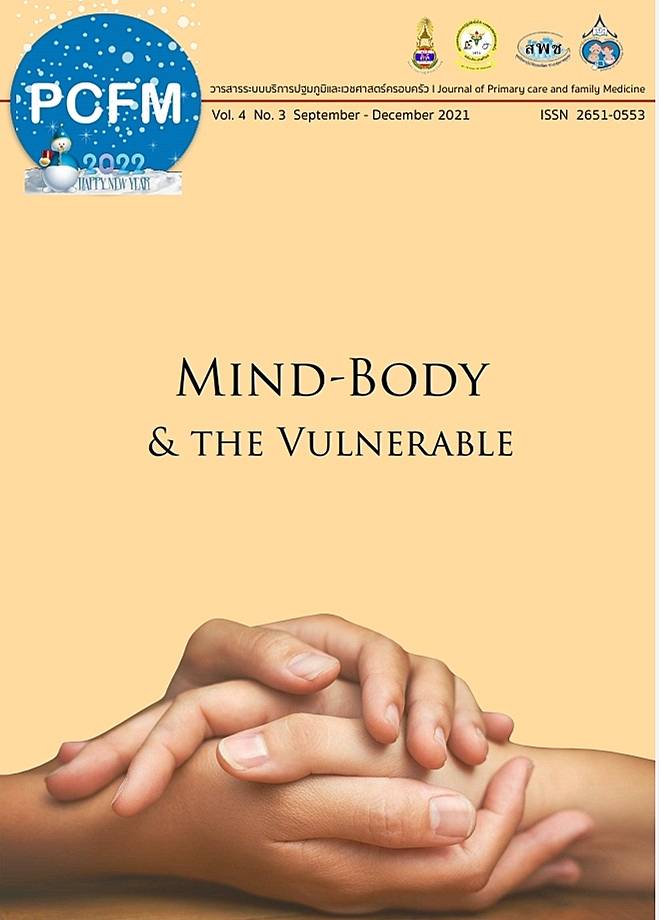การประเมินความแม่นยำของเครื่องมืออ่านภาพรังสีทรวงอกอัตโนมัติปัญญาประดิษฐ์(Artificial Intelligence; AI) ในการแปลผลวัณโรคปอดจากภาพรังสีทรวงอกในผู้ป่วยนอกที่มีอาการสงสัยวัณโรคปอด อ.แม่ระมาด จ.ตาก
Main Article Content
บทคัดย่อ
ความเป็นมา: ภาพรังสีทรวงอก (CXR) เป็นเครื่องมือสำคัญในการคัดกรองวัณโรค ปัจจุบันยังพบข้อจำกัดในการแปลผล CXR เครื่องมืออ่านภาพรังสีทรวงอกอัตโนมัติปัญญาประดิษฐ์ (Artificial Intelligence; AI) จึงถูกนำมาใช้แปลผลภาพ CXR เพื่อประโยชน์ด้านการคัดกรองวัณโรคปอด
วัตถุประสงค์: ศึกษาความแม่นยำของ AI ในการแปลผล CXR ของผู้ป่วยที่มีอาการสงสัยวัณโรคปอดโดยใช้ผลตรวจเสมหะด้วยกล้องจุลทรรศน์ (AFB) และการวินิจฉัยวัณโรคด้วยอาการเป็นเครื่องมืออ้างอิง ในผู้ป่วยพื้นที่ อ.แม่ระมาด จ.ตาก
ระเบียบวิธีวิจัย: ศึกษาคุณสมบัติของเครื่องมือเพื่อการวินิจฉัยแบบเก็บข้อมูลย้อนหลังของ AI บริษัท อินเทอร์เน็ตประเทศไทย จำกัด(INET) ด้วยการเก็บข้อมูลในกลุ่มผู้ป่วยที่ได้รับการตรวจ CXR และเสมหะ AFB ร่วมกับมีอาการสงสัยวัณโรคในช่วงกุมภาพันธ์-กันยายน 2563 โดยศึกษาถึง Sensitivity, Specificity, Positive Predictive Value(PPV), Negative Predictive Value(NPV) และ Area Under the Curve(AUC) ที่เกณฑ์คะแนน(cut off score) 70 คะแนน และศึกษา cut off score ที่ทำให้ AI มี sensitivity>90%
ผลการวิจัย: เมื่อใช้ผลเสมหะ AFB เป็นเครื่องมืออ้างอิง AI มี Sensitivity 89.65%, Specificity 74.38%, PPV 16.25%, NPV 99.23% และ AUC 0.888(95% CI 0.827-0.949) เมื่อใช้การวินิจฉัยวัณโรคด้วยอาการเป็นเครื่องมืออ้างอิง AI มี Sensitivity 85.42%, Specificity 76.39%, PPV 25.62%, NPV 98.21% และ AUC 0.885(95% CI 0.842-0.928) เมื่อต้องการ Sensitivity >90% ควรกำหนดค่า cut off score ที่ 38-54 คะแนน
สรุปผลการวิจัย: AI มีคุณสมบัติที่ดีในการแปลผลภาพ CXR เพื่อช่วยวินิจฉัยวัณโรคปอด ในกลุ่มผู้ป่วยที่มีอาการเข้าได้กับวัณโรคที่มารับการตรวจที่โรงพยาบาล
Article Details
เนื้อหาและข้อมูลในบทความที่ลงตีพิมพ์ในวารสาร PCFM ถือเป็นข้อคิดเห็นและความรับผิดชอบของผู้เขียนบทความโดยตรง ซึ่งกองบรรณาธิการวารสารไม่จำเป็นต้องเห็นด้วยหรือร่วมรับผิดชอบใด ๆ
บทความ ข้อมูล เนื้อหา รูปภาพ ฯลฯ ที่ได้รับการตีพิมพ์ลงในวารสาร PCFM ถือเป็นลิขสิทธิ์ของวารสาร PCFM หากบุคคลหรือหน่วยงานใดต้องการนำทั้งหมดหรือส่วนหนึ่งส่วนใดไปเผยแพร่ต่อหรือเพื่อกระทำการใด ๆ จะต้องได้รับอนุญาตเป็นลายลักษณ์อักษรจากวารสาร PCFM ก่อนเท่านั้น
เอกสารอ้างอิง
2. สำนักวัณโรค กรมควบคุมโรค. แนวทางการควบคุมวัณโรคประเทศไทย พ.ศ.2561. กรุงเทพฯ: อักษรกราฟฟิกแอนด์ดีไซน์; 2561.
3. Qin ZZ, Sander MS, Rai B, Titahong CN, Sudrungrot S, Laah SN, et al. Using artificial intelligence to read chest radiographs for tuberculosis detection: A multi-site evaluation of the diagnostic accuracy of three deep learning systems. Sci Rep [Internet]. 2019;9(1):1–10. Available from: http://dx.doi.org/10.1038/s41598-019-51503-3
4. Murphy K, Habib SS, Zaidi SMA, Khowaja S, Khan A, Melendez J, et al. Computer aided detection of tuberculosis on chest radiographs: An evaluation of the CAD4TB v6 system. Sci Rep [Internet]. 2020;10(1):1–11. Available from: http://dx.doi.org/10.1038/s41598-020-62148-y
5. Pande T, Cohen C, Pai M, Ahmad Khan F. Computer-aided detection of pulmonary tuberculosis on digital chest radiographs: A systematic review. Int J Tuberc Lung Dis. 2016;20(9):1226–30.
6. Breuninger M, Van Ginneken B, Philipsen RHHM, Mhimbira F, Hella JJ, Lwilla F, et al. Diagnostic accuracy of computer-aided detection of pulmonary tuberculosis in chest radiographs: A validation study from sub-Saharan Africa. PLoS One. 2014;9(9).
7. Zaidi SMA, Habib SS, Van Ginneken B, Ferrand RA, Creswell J, Khowaja S, et al. Evaluation of the diagnostic accuracy of Computer-Aided Detection of tuberculosis on Chest radiography among private sector patients in Pakistan. Sci Rep [Internet]. 2018;8(1):1–9. Available from: http://dx.doi.org/10.1038/s41598-018-30810-1
8. Habib SS, Rafiq S, Zaidi SMA, Ferrand RA, Creswell J, Van Ginneken B, et al. Evaluation of computer aided detection of tuberculosis on chest radiography among people with diabetes in Karachi Pakistan. Sci Rep. 2020;10(1):1–5.
9. Muyoyeta M, Maduskar P, Moyo M, Kasese N, Milimo D, Spooner R, et al. The sensitivity and specificity of using a computer aided diagnosis program for automatically scoring chest X-rays of presumptive TB patients compared with Xpert MTB/RIF in Lusaka Zambia. PLoS One. 2014;9(4):16–8.
10. Chanchaichujit J., Tan A., Meng F., Eaimkhong S.. Application of artificial intelligence in healthcare. In: Healthcare 4.0. Singapore: Palgrave Pivot; 2019. p. 63–93
11. Park SH, Han K. Methodologic guide for evaluating clinical performance and effect of artificial intelligence technology for medical diagnosis and prediction. Radiology. 2018;286(3):800–9.
12. Osatavanichvong K, de Goes Nakano E, Dessí G, Saksirinukul T. Evaluation Artificial Intelligent (Ai) Assists Radiologist in Radiographic Chest Interpretation. Bangkok Med J. 2018;14(2):59–65.
13. สำนักวัณโรค กรมควบคุมโรค. การคัดกรองเพื่อค้นหาวัณโรคและวัณโรคดื้อยา (Systematic screening for active TB and drug-resistant TB). พิมพ์ครั้งที่ 2. กรุงเทพฯ: อักษรกราฟฟิกแอนด์ดีไซน์; 2561.
14. Lakhani P, Sundaram B. THORACIC IMAGING: Deep Learning at Chest Radiography Lakhani and Sundaram. Radiol n Radiol Radiol [Internet]. 2017;284(2—August). Available from: http://pubs.rsna.org.ezp-prod1.hul.harvard.edu/doi/pdf/10.1148/radiol.2017162326
15. Mandrekar JN. Receiver operating characteristic curve in diagnostic test assessment. J Thorac Oncol [Internet]. 2010;5(9):1315–6. Available from: http://dx.doi.org/10.1097/JTO.0b013e3181ec173d
16. Khan FA, Majidulla A, Tavaziva G, Nazish A, Abidi SK, Benedetti A, et al. Articles Chest x-ray analysis with deep learning-based software as a triage test for pulmonary tuberculosis: a prospective study of diagnostic accuracy for culture-confirmed disease. Lancet Digit Heal [Internet]. 2(11):e573–81. Available from: http://dx.doi.org/10.1016/S2589-7500(20)30221-1
17. ศศิธร ศรีโพธิ์ทอง, วิโรจน์ วรรณภิระ, วาสนา เกตุมะ. การคัดกรองวัณโรคปอดในกลุ่มเสี่ยงและประสิทธิภาพของแบบคัดกรองอาการสงสัยวัณโรคปอด. พุทธชินราชเวชสาร 2018;35(3):394–400.
18. ศิริพร อุปจักร์, วิลาวัณย์ พิเชียรเสถียร, จิตตาภรณ์ จิตรีเชื้อ. ประสิทธิภาพของแบบคัดกรองวัณโรคปอดในโรงพยาบาล. พยาบาลสาร 2016;43(January):107–17.
19. Nash M, Kadavigere R, Andrade J, Sukumar CA, Chawla K, Shenoy VP, et al. Deep learning , computer- aided radiography reading for tuberculosis: a diagnostic accuracy study from a tertiary hospital in India. Sci Rep [Internet]. 2020;1–10. Available from: http://dx.doi.org/10.1038/s41598-019-56589-3


